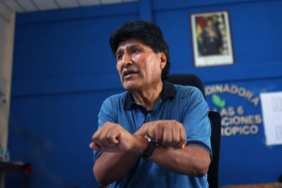Kaynak: www.npr.org

Beni the llama gets a hug and inspires a laugh from a traveler at Portland International Airport last week.
Jay Fram for NPR
hide caption
toggle caption
Jay Fram for NPR
When Beni the llama and Captain Jack the alpaca saunter with their handlers through the front doors of the Portland International Airport on a recent morning, time seems to stop.
People who were moments earlier hustling to their gates stand still. Those who were occupied with their phones look up and stare. Some take videos. A crowd quickly forms. Within minutes, a dozen people are lined up for the chance to have their picture taken with one of these animals.
At least one traveler is moved to tears.
“You can tell by my response how joyful I feel to see these animals out here,” says Lori Sackett, who is on her way from Portland to San Antonio with her husband to see their adult daughter. “What a gift.”
Sackett is especially nostalgic about llamas since she worked with them in the 4-H youth group when her daughter was young – the same daughter she’s on her way to visit. “She’s gonna just go wild when she sees the pictures,” says Sackett. “I mean, it’s a magical thing.”
Magic is a word invoked by more than one of the dozens of travelers who pause their journeys for a few minutes to get to know these animals. Part of the Portland airport’s animal therapy program, the animals visit every few weeks from the farm where they live – called Mountain Peaks Therapy. When they’re not at the airport, they have a busy schedule that includes corporate events and weddings.
Their airport appearances are part of an effort on the part of the airport to acknowledge that travel is anxiety producing, says Allison Ferre, spokesperson for the Port of Portland. A recent airport redesign also features live trees bathed in natural light and lofty ceilings built with locally sourced Douglas Fir. “Being in nature is a stress reliever,” says Ferre. “The therapy animals that come in is just one way we kind of deliver on that for the traveler experience.”

Captain Jack the Alpaca has a job to do: making travelers happy. Clearly, he gets it done.
Jay Fram for NPR
hide caption
toggle caption
Jay Fram for NPR
But the fervor on this day transcends the description of stress reliever or nature observation. Over and over, people gasp and cry out in amazement as they embrace the gentle animals’ long necks or pet their fluffy ears.
Sackett says the llama magic is hard to describe without experiencing it. “Have you touched one?” she offers in explanation – “I mean – they are soft and beautiful. The sweet faces.”
Therapy programs with animals in airports are different from emotional support or service animals, which typically travel with individuals. By contrast, therapy animals are insured and credentialed through organizations like animal hospitals or industry groups, and subject to little state and federal regulation.
There is some evidence that animals in therapy programs have a calming effect on people, but “the reality is we need more research,” says Nancy Gee, Director of the Center for Human Animal Interaction at Virginia Commonwealth University School of Medicine. While therapy animals can include a range of species such as fish and horses, the majority of existing research is with dogs.

“It’s a magical thing,” says Lori Sackett, who went in for a llama “carrot kiss.” Seeing the animals moved her to tears.
Jay Fram for NPR
hide caption
toggle caption
Jay Fram for NPR
Support for these animal ambassadors is primarily predicated on their immediate evidence – that people are surprised and delighted to encounter animals at an airport. “These programs are wildly popular,” says Gee. “People absolutely love them.”
“I think dogs elicit the same emotion,” says Sackett. “But isn’t this a million times more magnificent?”
Not all llamas and alpacas are good candidates for this kind of therapy, however, according to Shannon Joy, co-owner of Mountain Peaks Therapy. “Llamas and alpacas are very herd oriented,” says Joy. “They feel safer amongst their peers.”
Working with local breeders, she looks for animals to recruit that are “curious about us as humans. That shows that that animal is confident.”
In order to be credentialed as therapy animals, llamas and alpacas undergo extensive training, says Joy. Among other things, the animals have to learn to tolerate being handled by many people. “It’s maybe one in 15 llamas that are going to have that level of confidence and bodily autonomy.” She puts the number of Alpacas at one in 75. “It’s very rare.”
A favorite party trick both animals perform is giving “carrot kisses,” a move that involves pecking a carrot out of a human mouth.

Shannon Joy (left) and her mother Lori Gregory from Mountain Peaks Therapy Llamas & Alpacas, pose for portraits with Beni and Captain Jack at Portland International Airport on October 31, 2024.
Jay Fram for NPR
hide caption
toggle caption
Jay Fram for NPR
Varun Kataria is at first apprehensive, but eventually persuaded. “Oh OK. I’ll try,” he laughs and offers up a carrot in his teeth to Beni the llama. “Well done!” says Joy. “Magical?”
“I don’t think I’ve put my mouth on an animal’s mouth before,” says Kataria, who is on his way home from a work trip. “It’s kind of a nerve wracking experience.”
Kataria says he’s feeling stressed after the travel, and feels preoccupied with plans for a party he’s throwing later for Diwali.
But after this moment, he says, “I feel good.” The experience of kissing a llama snapped him right out of his worries.





Yorumlar kapalı.